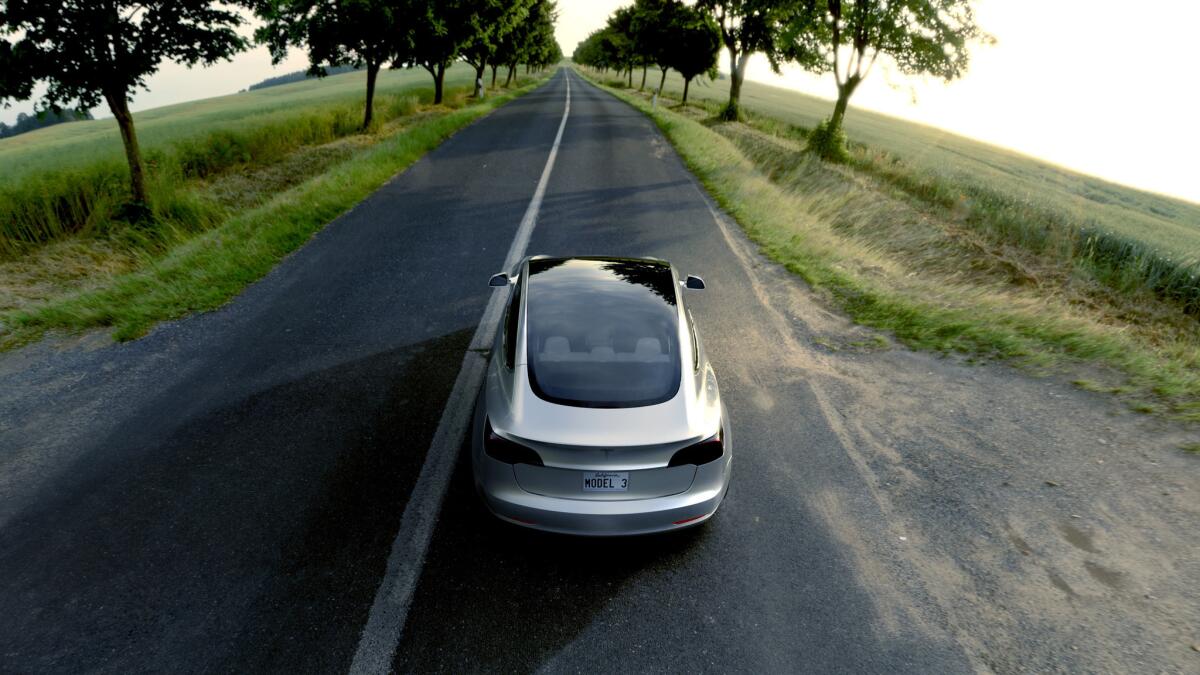Electric vehicle sales are up sharply in California, mostly due to Tesla

- Share via
Sales of new electric vehicles in California shot up 63.7% in the first half of the year, to 51,750 units, largely on the strength of the Tesla Model 3.
But that doesn’t mean a golden age of electric vehicles has dawned. Pure electric cars still total only 5.5% of California car sales. Consumers, for the most part, are shrugging at EV offerings from car companies not named Tesla. And Tesla sales could be topping out.
“California is the largest green market in the country,” said Jessica Caldwell, market analyst at Edmunds. The state accounts for nearly half of the 105,472 pure EVs sold nationwide. “But EVs are still a tough market, even in California.”
Dealers sold nearly 950,000 new automobiles statewide in the first six months of 2019, according to the California New Car Dealers Assn. About 13% of them were “electrified” in some form — pure EV, hybrid or plug-in hybrid.
Practically all the rest run on internal combustion engines, the vast majority on gasoline. Gasoline car sales have fallen 7.3% in California thus far this year, partly because of electrified competition and partly because auto sales nationally (and internationally) have entered a cyclical downturn of yet-unknown severity.
Statewide sales of new hybrid cars, which run mainly on gasoline with an electric battery boost and don’t need to be plugged in, rose 22.1% in the first half, to 48,861 vehicles. Plug-in hybrids, which can run on battery power for a few dozen miles before having to switch to internal combustion, plummeted 28.5%, to 35,500 vehicles — in part, analysts have said, because consumers recoiled from the latest design of the plug-in hybrid leader, the Toyota Prius Prime.
Without Tesla, pure EV sales would be limp. About 33,000 Model 3s were sold in California in the first half. The next-highest seller was Chevrolet’s Bolt EV, at 4,482 cars, followed by the Tesla Model X (3,690) and the Tesla Model S (3,390.) The Nissan Leaf sold 2,034 units.
Electric car buyers “don’t seem to be EV fans, they seem to be Tesla fans,” Caldwell said. “It’s been really hard for any other company to crack the code of what people want in an EV.”
Still, driven by policymakers in Europe, China, California and a dozen other U.S. states, automakers around the world are retooling themselves to build and, they hope, sell millions of electric vehicles. The car companies talk about cutting air pollution and relieving global warming. But unless governments ban sales of new internal combustion engine-propelled cars, consumer acceptance could be gradual.
One reason for the slow transition is cost. Batteries remain expensive, and EVs generally cost more. The base price of a gasoline-powered Hyundai Kona compact SUV, for instance, is $18,740; the all-electric version is $36,950, before government incentives. Other barriers: range anxiety and a shortage of public charging options.
Partly because of their high costs, electric cars so far have proved unprofitable. Carmakers are selling them at a loss. Government subsidies on electric car purchases have proved necessary to keep consumers interested.
Carmakers hope that production levels will reach the point where per-car costs fall, subsidies are no longer necessary and EVs can be sold at a profit. When that point will be reached, no one can say.
Tesla succeeded in becoming the world’s first mass-market EV manufacturer with the Model 3, with a base price of $39,000. But the 16-year-old company has yet to make an annual profit, and it’s selling cars at only a bit over half the 500,000 annual rate it had told Wall Street to expect by now. The company’s overall sales curve is flattening.
The Trump administration is battling with California over auto emissions and fuel economy regulations. If the White House is successful, EV sales growth could take a drubbing. California has been allowed to require tougher emissions standards than the federal government’s, and other states have been allowed to follow California’s lead. Under the Obama administration, California and federal motor vehicle clean air rules were made the same. The Trump administration wants to roll back emissions and fuel requirements and force California and the other states to conform with the weaker federal rules.
Four automakers — Ford, Honda, Volkswagen and BMW — have agreed to a compromise with California to keep most of the existing requirements in place. Other companies, including General Motors, have not taken a stand on the compromise. The U.S. Department of Justice has opened an investigation into whether the four automakers broke the law with the agreement.
All carmakers have said they need consistent regulations to meet global regulatory goals toward cleaner vehicles. But those goals are out of sync, for now, with the market. A recent report from independent Europe auto analyst Matthias Schmidt said that, to meet ambitious European Union air requirements, plug-in sales would have to more than double next year.
“One potential issue could be that manufacturers are forced” to incur losses to meet the targets, and individual European governments are likely to have to support manufacturers with increased purchase incentives or other “fiscal tools” to prop up sales and reduce automaker losses.
More to Read
Inside the business of entertainment
The Wide Shot brings you news, analysis and insights on everything from streaming wars to production — and what it all means for the future.
You may occasionally receive promotional content from the Los Angeles Times.









